
Moni Varsamonerou
The Monastery of Varsamoneros was one of the most important centres of the Cretan School of Hagiography and is connected with the monastery of Vrontisiou. Most of the buildings of the monastery are now destroyed and only a few architectural elements from the complex are preserved.
The three-aisled church, which is dedicated to the Virgin Mary and Saints Fanourios and Ioannis, is one of the few that is preserved in good condition. The oldest aisle must be that of Panagia where inscriptions dating back to 1332 are preserved. The transverse western aisle is dedicated to Agios Fanourios and was built in 1426 while it was hagiographed in 1431 by the painter Constantinos Rico. The southern aisle dedicated to Agios Ioannis was built around 1400. The frescoes of the church are kept in very good condition and are considered of great artistic and scientific value. Also of great value is the wood-carved iconostasis of the 16th century as well as a wood-carved pulpit and throne that can be found today in the Historical Museum of Heraklion. The temple is not always open to visitors. To get inside you can get information from the Monastery of Vrontisiou or look for the guard in the village of Vorizia about 2.5 km before the monastery.
This is a beautiful region of Crete island to explore in full, right at the southern foothills of Mount Psiloritis and with countless archaeological, cultural and other attractions in the area. The village of Zaros, the artificial lake of Votomos and the forest of Rouvas are located nearby, while there are various gorges to hike and explore. The E4 European long-distance path also crosses through the area. To the north, you will find Ideon Antron, considered one of the possible locations where the god Zeus was born and raised. The Monastery of Varsamoneros might not be active anymore but the history is still present in the aura and ruins, a truly magnificent place to visit.